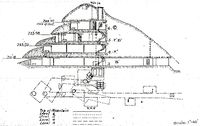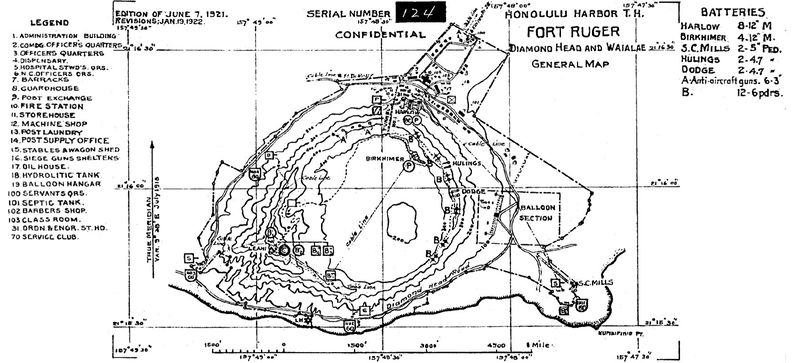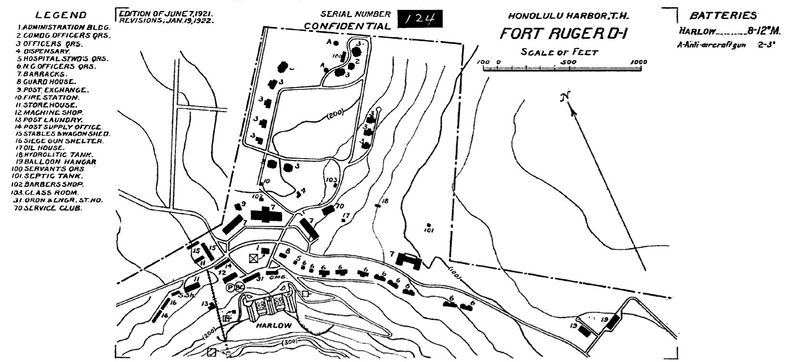Fort Ruger
|
Fort Ruger (1906-1955) - A U.S. Army Coastal fortification first established as Diamond Head Military Reservation in 1906 on Oahu Island, Honolulu County, Hawaii. Named Fort Ruger in G.O. 15, 1909, after Major General Thomas H. Ruger (Cullum 1633), a Superintendent of the United States Military Academy who served in the U.S. Civil War and became a Major General at age 29. Abandoned in 1955. Endicott Period (1890-1910)Part of the Harbor Defense of Honolulu. On 12 Aug 1898 Hawaii was formally annexed as an American Territory. Shortly thereafter U.S. engineers and troops arrived to establish the first U.S. garrison. The initial garrison was housed in a series of temporary camps until President Theodore Roosevelt established military reservations on 18 Jan 1906. The 1 Feb 1906 report of the Taft coastal defenses board recommended that Hawaii, specifically Honolulu and Pearl Harbor, be protected by coastal artillery batteries. The list of recommended armament included sixteen 12" mortars, six 12" guns and four 6" guns. Initially, four forts were established to provide the gun batteries, Fort Kamehameha, Fort Ruger, Fort De Russy (2) and Fort Armstrong (2). Fort Ruger was to be the recipient of a mortar battery with eight 12" mortars. The Diamond Head Military Reservation was established on 27 Jan 1906 with an initial 720 acres that soon expanded to 755 acres. The reservation was renamed Fort Ruger 28 Jan 1909 for Major General Thomas Howard Ruger.
Fort Ruger was built out as four company harbor defense fort for Honolulu Harbor with the cantonment outside the north side of the Diamond Head crater and coastal gun batteries in and around the crater. The first battery built was Battery Harlow with eight, 12" mortars. This battery was started in 1907 and completed in 1910 on the north slope of the crater. Four more smaller caliber batteries were begun in 1914 and another mortar battery was begun in 1915. The second mortar battery only housed four of the 12" mortars as was the practice for the newer mortar batteries. Besides the coastal gun batteries on Fort Ruger there were also supporting fire control stations and battery commander posts built around 1911. One fire control post was located atop the south rim of Diamond Head Crater and contained four levels of fire control stations. Also supporting the smaller caliber coastal gun batteries were five 60" coastal searchlight positions for night illumination of enemy high speed motor torpedo boats and other close in attackers.
World War I (1917-1918)
The configuration of the batteries remained the same through World War I but the disarmament after the war saw four batteries deactivated (Battery S.C Mills, Battery Dode, Battery Hulings and the Unnamed Battery). In 1920 an Air Service depot was built on the east side of Fort Ruger to accommodate a fire control observation ballon company. A balloon hanger and barracks were built at the new depot and three sets of quarters for the balloon company officers were built on the main post in 1920. The headquarters of the Harbor Defenses of Honolulu came to Fort Ruger in January 1927. In 1932 work began on a bombproof Harbor Defense Command Post (HDCP or "H" Station) built into the Kapahulu Tunnel. The new complex of eight rooms included the old fire control switchboard room and became the new Harbor Defense Command Post. In the 1930s two batteries were added, Battery Granger Adams and Battery 155 - Fort Ruger. Battery 155 - Fort Ruger was a battery of 155mm field mount guns on concrete Panama mounts located on the north side of the cantonment oriented more for land side defense than coastal protection.
World War II (1941-1945)
After World War II began Battery 407 was started as a casemated battery built into a tunnel in the south side of Diamond Head Crater. Work on the battery was discontinued before completion at the end of the war in 1945 and it was never armed. In 1943 both mortar batteries were deactivate because they were obsolete and would be completely ineffective in any naval battle. At the end of the war only Battery Granger Adams was still active, it was deactivated in 1946. Cold War (1947-1991)In January 1950 Fort Ruger became the headquarters of the Hawaii National Guard. In 1955 most of the Fort Ruger reservation was turned over to Hawaii with the U.S. Army retaining the parade and Palm Circle until 1974 and the Cannon Club (officers club) until 1997. The fort's cantonment area became the University of Hawaii’s Kapiolani Community College. Current StatusPart of Diamond Head State Monument, Honolulu, Honolulu County, Hawaii. The cantonment area is now the University of Hawaii’s Kapiolani Community College campus and all the original post buildings are destroyed. The Cannon Club was destroyed by fire in 2003. Most of the still existent battery sites and fire control station sites remain in the possession of federal or state agencies. USGS Geographic Names Information System (GNIS) Database Entry: 2512218
Sources:
Links:
Visited: No
| ||||||||||||||||||||||||||||||||||||||||||||||||||||||||||||||||||||||||||||||||||||||||||||||||||||||||||||||||||||||




